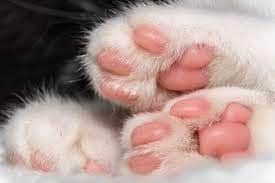Contents
Cat pads: why take care of them?
Cat pads, also called balls, have many functions. Any damage or injury to one of these pads can be painful and disabling. Therefore, taking good care of your cat’s pads is important for their health and well-being. In any case, if you have the slightest doubt, do not hesitate to contact your veterinarian.
Claw cut
Made up of keratin like our nails and hair, cat claws grow continuously. Cats naturally scratch on many surfaces. This allows them to maintain them by removing the dead horny layers but also to sharpen them. It is a normal behavior essential to their well-being.
Cats with access to the outdoors generally have little need for a nail clipping. This mainly concerns cats living indoors as well as older cats. To do this, it is essential to have a nail clipper specially designed for cats. Indeed, this is necessary for their safety in order to avoid any injury. Cat’s claw is made up of blood vessels contained in what is called the nail matrix. This is the pink part that can be seen by transparency of the nail. It is this part that will bleed if the claws are cut too short. It is therefore important to cut only the end where the die is not present. Before cutting, be sure to bring out the claw by exerting light pressure on the finger to deploy it before cutting its end.
However, if you’ve inadvertently cut a claw too short and it’s bleeding, don’t panic. All you need to do is put on a compress and apply pressure on the end of the claw for several minutes. Do not hesitate to get help from another person while the hemostasis (stop bleeding) takes place. Be sure to keep an eye on this nail in the days that follow. If you find that it is painful, infected, or any other abnormal condition, see your veterinarian.
In addition, cutting the claws can be complicated if your cat is not cooperative. In this case, for your safety and that of your cat, do not hesitate to call your veterinarian.
What to do if the pads are injured?
Cold
The cold can damage the pads with the appearance of cracks. They do not cause bleeding and are the result of a lack of hydration of the pads. Solutions exist to remedy this. Many moisturizing pad balms are now commercially available. For more information on which balm to use on your cat, do not hesitate to contact your veterinarian.
Burns
The cat’s pads can be burnt in several cases. First in winter, the salt used for snow on the roads can be caustic to the pads that are exposed to it for a long time. In addition, in summer in the event of hot weather, the pads can burn on contact with surfaces that heat easily, such as bitumen. A consultation with your veterinarian may then be necessary. It is therefore recommended not to let your cat go outside in extreme temperatures and to take him out during the cooler hours in summer.
cut
Cuts of the pads frequently occur when the cat walks on glass or sharp objects for example. This usually results in lameness and bleeding from the affected pad. In this case, rinse the wound with clean water and bandage before going to your vet. Depending on the severity, a cut in a pad can be an emergency, especially if a foreign object has become lodged in it.
Pododermatite plasmocytaire
Plasma cell pododermatitis is a rare dermatological disease in cats. This is an inflammation of the pads that swell, become soft, and may change color to purplish. This disease is painful and can therefore cause lameness in cats. In rare cases, the nose and mouth can also be affected. Complications can be serious like ulcers with bleeding leading to bacterial infections. Treatment prescribed by your veterinarian will help fight this disease.
Anatomy of the cat’s pads
The cat is an animal called digitigrade, that is to say that it walks on its fingers. Its pads are organized in this way:
- The front (or foreleg) legs are each made up of 7 pads: 1 lug pad (first finger that is not in contact with the ground), 4 finger pads (each protecting a finger in contact with the ground) , 1 metacarpal pad (also in contact with the ground) and 1 carpal pad (placed higher and not in contact with the ground);
- The hind legs (or hind legs) are each composed of 5 pads: 4 finger pads (which each protect a finger in contact with the ground) and 1 metatarsal pad (also in contact with the ground).
Each finger has a nail, or claw, at its end. These claws are continuously growing just like in humans, so they should be taken care of, especially if your cat is not using them enough on her own. The peculiarity of the cat’s claws is that they are retractable. Thus they do not make noise when the cat is walking, unlike dogs. They are therefore much more complex. Particularly suitable for hunting, they are sharper and form a well rounded curve. Claws are also important for the cat’s territorial marking behavior, this is called visual marking. Thus, by scratching a support, the cat shows others that it is his territory. This natural behavior is a means of communication.
Just like in dogs, the cat’s paws allow it to move on different soils. The pads, which have a cushioning and insulating role, protect the cat’s fingers. It is also through the pads, made up of sweat glands, that cats sweat. In addition, these glands are also used to secrete pheromones to mark its territory when the cat claws or during its movements, it is the olfactory marking.










